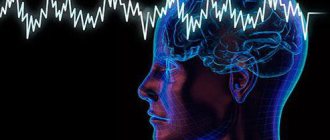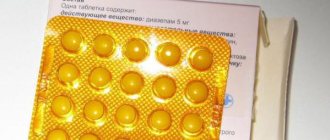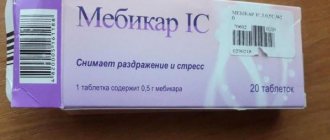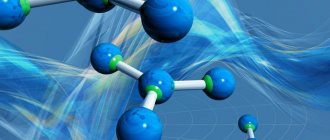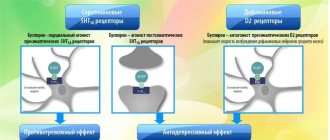| Phenazepam | |
| Phenazepamum | |
| Phenazepam | |
| Chemical compound | |
| IUPAC | 7-bromo-5-(ortho-chlorophenyl)-2,3-dihydro-1H-1,4-benzodiazepin-2-one |
| Gross formula | C₁₅H₁₀BrClN₂O |
| Molar mass | 349.609 g/mol |
| CAS | 51753-57-2 |
| PubChem | 40113 |
| Classification | |
| ATX | N05BX |
| Pharmacokinetics | |
| Metabolism | liver |
| Half-life | 18 hours |
| Excretion | kidneys |
| Dosage forms | |
| solution for intravenous and intramuscular administration, tablets | |
| Other names | |
| "Phenazepam", "Phenorelaxan", "Fesipam", "Elzepam", "Fenzitat" | |
| Phenazepam on Wikimedia Commons | |
Phenazepam
(active ingredient -
bromodihydrochlorophenylbenzodiazepine
) is a drug from the benzodiazepine group with tranquilizing (anxiolytic), anticonvulsant, hypnotic, muscle relaxant and sedative effects [1]. White or white with a creamy tint crystalline powder, practically insoluble in water, slightly soluble in alcohol, ether, chloroform, soluble in toluene, benzene, dioxane, dimethylformamide [2].
Content
- 1 History of the creation of the drug
- 2 Receipt
- 3 General information
- 4 Pharmacokinetics
- 5 Indications
- 6 Mechanism of action
- 7 Contraindications
- 8 Side effects 8.1 Correction of side effects
- 14.1 By country
How is it with them and how is it with us?
Doctors are very careful when treating patients with Phenazepam. In addition to the fact that the drug gives a certain result in the treatment of such ailments as epilepsy, insomnia, anxiety and depression, alcohol withdrawal, it potentially causes a whole list of side effects.
Doctors especially focus on stopping the drug. This should be done very carefully and gradually. And under no circumstances should you try to do this yourself. If your appointment is nearing the end, you should consult a doctor.
Very often, doctors prescribe drug withdrawal in a hospital in order to monitor the patient. For those people who do not like to follow doctors' instructions, this is important.
If we compare treatment methods, in the West they refuse drugs that have a strong effect, like Phenazepam. They resort to analogues, which have a milder effect, but often provide a longer lasting effect.
If you go for a consultation with a doctor, and he does not prescribe you Phenazepam, but an analogue from the group of over-the-counter drugs, then this is a clear sign that he treats according to European standards.
Experts note the harmfulness of all tranquilizers without exception. When resorting to Phenazepam, it should be remembered that it was developed back in the seventies, and then was intended only for military purposes. Later he entered civilian production. Today there is a strong tendency to abandon therapy with this drug in favor of its analogues.
History of the drug's creation
Phenazepam is the first benzodiazepine tranquilizer created in the USSR.
In the early 1970s, a group of scientists led by V.V. Zakusov received a state order to create a domestic tranquilizer. The molecule was synthesized at the Odessa Physicochemical Institute of the Ukrainian SSR Academy of Sciences (S. A. Andronati and A. V. Bogatsky) [3]. The names of many other prominent scientists are associated with the development of phenazepam - S. B. Seredenin and T. A. Voronina (pharmacological screening, selection and study), G. Ya. Avrutsky and Yu. A. Aleksandrovsky (clinical efficacy and safety).
For its receipt (1974), implementation (1978) and creation of the scientific basis of a new branch of military medicine (military psychopharmacology) to a group of Soviet scientists - G. Ya. Avrutsky, Yu. A. Aleksandrovsky, S. A. Andronati, A. V. Bogatsky , Yu. I. Vikhlyaev, T. A. Voronina, V. V. Zakusov, A. L. Zyuban, B. V. Ovchinnikov, S. B. Seredenin, L. I. Spivak, G. V. Chuchkin - awarded USSR State Prize (1980).[4][5]
Melaxen is the most famous over-the-counter analogue
Melaxen is officially an over-the-counter analogue of Phenazepam.
It’s worth clarifying right away: if a medical product is over-the-counter, this indicates its high level of safety for humans.
Melaxen can be taken independently by those who are trying to eliminate insomnia. The drug as a whole is a chemical analogue of melatonin, a natural sleep hormone. Consequently, it acts in the body quite organically.
This means that the patient’s sleep phases are not disturbed, and sleep itself becomes restorative, complete rest.
Using Melaxen will relieve such troubles as daytime sleepiness, incoordination, nightmares and attention or memory problems.
Receipt
Synthesis scheme according to the method of S. A. Andronati, A. V. Bogatsky and Yu. I. Vikhlyaev, developed at the Physico-Chemical Institute of the Academy of Sciences of the Ukrainian SSR [3]:
First, 2-(o-chlorobenzoylamino)-5-bromo-2-chlorobenzophenone is obtained by acylation of p-bromoaniline with o-chlorobenzoic acid chloride in the presence of a catalyst - zinc chloride. 2-(o-chlorobenzoylamino)-5-bromo-2-chlorobenzophenone is hydrolyzed with aqueous sulfuric acid to give 2-amino-5-bromo-2-chlorobenzophone. 2-amino-5-bromo-2-chlorobenzophone is acylated with aminoacetic acid chloride hydrochloride in chloroform. Then 2-(aminomethylcabronylamino)-5-bromo-2-chlorobenzophenone hydrochloride is formed, which is converted into a base with aqueous ammonia and then thermally cyclized to bromodihydrochlorophenylbenzodiazepine
[2].
Aminoacetic acid chloride hydrochloride is prepared by treating aminoacetic acid with phosphorus(V) chloride in chloroform.
Phenibut
Phenibut is an anxiolytic pharmacological agent that has a psychostimulant effect . The main component of the drug is aminophenylbutyric acid . The substance is evenly absorbed throughout the body. The main metabolism occurs in the liver and is excreted by the kidneys after 10-12 hours. The drug has a tranquilizing and psychostimulating effect, and also, to a lesser extent, antiplatelet and antioxidant effects.
Phenibut helps normalize cerebral circulation . The medicine relieves feelings of anxiety, fear and tension, but at the same time, stimulates interest, as it increases mental and physical ability. It is worth noting that the drug does not have a sedative or stimulating effect.
general information
Phenazepam is a highly active tranquilizer. The strength of the tranquilizing and anxiolytic (anti-anxiety) action is superior to other benzodiazepine and abenzodiazepine tranquilizers[6]; It also has a pronounced anticonvulsant, muscle relaxant (muscle relaxant) and hypnotic effect. It is superior to diazepam in its anti-anxiety and hypnotic effects [7]. The strength of the hypnotic effect is close to nitrazepam[1]. When used together with hypnotic and opioid drugs, there is a mutual enhancement of the inhibitory effect on the central nervous system.
Drug interactions
When prescribing several medications, they must be taken separately, observing the time interval. You should definitely take Phenazepam with you. This drug is also not absorbed under the tongue or in the oral cavity together with other medications.
- Levodopa, when taken together, will not be fully effective.
- Zidovudine may become more toxic to the body.
- Other tranquilizers, sleeping pills, antiepileptic drugs, narcotic painkillers, centrally acting muscle relaxants and ethyl alcohol can mutually enhance the effect and side effects.
- MAO inhibitors increase toxicity.
- "Imipramine" increases its amount in the blood.
- When taken with drugs to lower blood pressure, hypotension may develop.
- "Clozapine" together with "Phenazepam" contributes to respiratory depression.
Indications
Phenazepam is prescribed:
- for various neurotic, neurosis-like, psychopathic and psychopath-like conditions, accompanied by anxiety, fear, increased irritability, emotional lability [1].
- for obsession, phobia, hypochondriacal syndromes, including hypochondriacal-senestopathic (including those resistant to the action of other tranquilizers); for phobias and obsessions, they are especially effective in combination with perphenazine (etaperazine) and trifluoperazine (triftazine) [8],
- for psychogenic psychoses, panic reactions, etc., as it relieves anxiety and fear[1],
- for the relief (relief) of alcohol withdrawal[1] and alcoholic delirium (a condition resulting from a sudden cessation of alcohol intake that occurs at stages II-III of alcoholism)[9],
- as an anticonvulsant (mainly for local, small, abortive seizures)[8], also for the treatment of patients with temporal lobe epilepsy and myoclonic epilepsy[10],
- as a sleeping pill,
- for premedication in preparation for surgical operations[11],
- for the prevention of emotional stress and states of fear[10],
- for the treatment of hyperkinesis and nervous tics[10],
- with muscle stiffness[10],
- for autonomic dysfunctions and autonomic lability [10].
- reduces affective tension in delusional disorders.
In combinations:
- for severe psychomotor agitation in manic or psychotic patients (in combination with antipsychotics and lithium salts) [12]: 724.
Phenazepam tablets: instructions, reviews and prices
Phenazepam is a highly active tranquilizer that has a pronounced anxiolytic, anticonvulsant, hypnotic and central muscle relaxant effect on the body. Instructions for use prescribe taking tablets (0.5, 1 and 2.5 mg) for the treatment of psychosis, sleep disorders, neurotic and psychopathic conditions.
Instructions for use will explain how to properly take tablets (including dispersible tablets 1 mg). In the reviews you can find out whether the drug helps in the treatment of neuroses, psychoses, epilepsy and other mental and psychosomatic disorders and diseases.
The drug Phenazepam is available in the form of tablets for oral administration in dosages of 500 mcg, 1 mg and 2.5 mg.
The tablets are white, flat-cylindrical, scored on one side. The medicine is packaged in blister packs of 10 pieces and 25 pieces in a cardboard box; the tablets are accompanied by an annotation with a detailed description of the characteristics.
Each tablet contains the active ingredient Phenazepam in a dosage of 500 mcg, 1 mg, 2.5 mg, respectively.
Phenazepam dispersible tablets for resorption in the mouth 1 mg are also produced.
What does Phenazepam help with?
Indications for use of the drug include:
- neuroses, pseudoneurotic (neurosis-like) states, psychopathy, psychopathic-like disorders and other conditions that are characterized by the appearance of a feeling of fear, increased anxiety, irritability, mood swings (its lability), increased tension;
- alcohol withdrawal syndrome;
- a sharp increase in tone and stable resistance of the muscles to the effects of deforming forces (muscle rigidity);
- instability (lability) of the autonomic nervous system;
- dyskinesia, tics;
- autonomic dysfunction syndrome;
- hypochondriacal syndrome, accompanied by various kinds of unpleasant or painful sensations (hypochondriacal-senestopathic syndrome; including in cases where treatment with other tranquilizers did not produce the expected result);
- temporal and myoclonic epilepsy;
- reactive psychosis;
- prevention of phobic conditions and conditions accompanied by a feeling of tension;
- sleep disorders;
- panic reactions.
The annotation for the drug also states that Phenazepam can be used for preliminary drug preparation of patients for general anesthesia and surgery.
Instructions for use
Phenazepam is prescribed orally. A single dose is usually 0.5-1 mg, and for sleep disorders - 0.25-0.5 mg 20-30 minutes before bedtime.
- For the treatment of neurotic, psychopathic, neurosis-like and psychopath-like conditions, the initial dose is 0.5-1 mg 2-3 times a day. After 2-4 days, taking into account the effectiveness and tolerability of the drug, the dose can be increased to 4-6 mg per day, the morning and afternoon dose is 0.5-1 mg, at night - 2.5 mg.
- In cases of severe agitation, fear, and anxiety, treatment begins with a dose of 3 mg per day, quickly increasing the dose until a therapeutic effect is obtained.
- When treating epilepsy, the dose is 2-10 mg per day.
- For the treatment of alcohol withdrawal, a dose of 2.5-5 mg per day is prescribed.
In neurological practice, for diseases with increased muscle tone, the drug is prescribed 2-3 mg 1 or 2 times a day. The average daily dose of Phenazepam is 1.5-5 mg, divided into 3 or 2 doses, usually 0.5-1 mg in the morning and afternoon and up to 2.5 mg at night. The maximum daily dose is 10 mg.
Phenazepam lozenges: how to take
The drug is taken orally regardless of food intake. The tablet is taken immediately after it is removed from the package. The tablet should be kept on the tongue until it is completely dissolved and then swallowed without liquid.
To avoid the development of drug dependence, during a course of treatment the duration of use of Phenazepam, like other benzodiazepines, is 2 weeks. But in some cases, the duration of treatment can be increased to 2 months. When discontinuing the drug, the dose is reduced gradually.
Side effects
- dizziness, headache;
- nausea;
- impaired memory, concentration, coordination of movements (especially at high doses);
- dry mouth;
- ataxia;
- possible paradoxical arousal;
- skin rash, itching;
- diarrhea;
- decreased libido;
- menstrual irregularities;
- dysuria;
- muscle weakness;
- drowsiness.
With prolonged use, especially in high doses, it can lead to addiction and drug dependence.
Children, pregnancy and breastfeeding
Phenazepam should not be used in the 1st trimester of pregnancy and lactation period. Pregnant women can take the medicine if absolutely necessary: the drug has a toxic effect on the fetus. The drug is contraindicated for children under 18 years of age.
Analogues of the drug Phenazepam
Analogues are determined by structure:
- Fesipam.
- Phenorelaxan.
- Elzepam.
- Fesanef.
- Tranquesipam.
Phenazepam analogues have a similar effect:
- Lorazepam.
- Grandaxin.
- Medazepam.
- Relium.
- Diazepam.
- Alprazolam.
- Valium.
- Sidenar.
- Laurenine.
- Relanium.
- Apaurin.
- Lorafen.
- Tofisopam.
- Sibazon.
- Nozepam.
- Tavor.
- Ativan.
- Seduxen.
Vacation conditions and price
The average price of Phenazepam (tablets) in Moscow is 105 rubles. Dispensed from pharmacies only with a doctor's prescription.
The tablets should be stored out of the reach of children, at room temperature. The shelf life of the drug is indicated on the packaging and is 4 years from the date of manufacture.
Source: https://instrukciya-po-primeneniyu.ru/fenazepam.html
Mechanism of action
Increases the inhibitory effect of gamma-aminobutyric acid (GABA) on the transmission of nerve impulses[13]. Stimulates BD receptors (in the allosteric center, etc.)[13].
Inhibits polysynaptic spinal reflexes, reduces the excitability of subcortical structures of the brain (thalamus, hypothalamus and limbic system)[13].
The anti-anxiety effect is due to the influence on the amygdala complex of the limbic system [13]. This effect reduces anxiety, fear, restlessness and emotional stress.
The sedative effect is associated with the influence on the nonspecific nuclei of the thalamus and the reticular formation of the brain stem [13]. In particular, this effect also reduces symptoms of neurotic origin, fear and anxiety [13].
The hypnotic effect is associated with inhibition of the cells of the reticular formation of the brain stem. Phenazepam reduces the impact of vegetative, emotional, motor (motor) stimuli that can disrupt the sleep mechanism, and helps to fall asleep faster.
The anticonvulsant effect occurs due to increased presynaptic inhibition. The excited state of the focus (excited nervous structure or group of neurons) does not eliminate, but the spread of the convulsive impulse is suppressed.
The central muscle relaxant effect occurs due to inhibition of both monosynaptic (to a small extent) and polysynaptic spinal afferent inhibitory pathways. Direct inhibition of muscle and motor nerve function is also likely to occur.
Phenazepam tablets instructions for use - analogues - effects on the body - reviews
Phenazepam is one of the best anti-anxiety drugs by world standards, which also has anticonvulsant and muscle relaxant properties. Inexpensive, but with a number of side effects.
Varieties of forms
Phenazepam is available in the form of tablets and solution. The tablet form is used more often, since the drug requires long-term use and the injection route may be accompanied by a risk of infection. Large white round tablets. Available in dosages of 0.5, 1 and 2.5 mg.
The solution is suitable for administering the drug intravenously and intramuscularly. Available in ampoules of 1 ml, dosage 1 mg. The phenazepam solution is transparent, some companies have a yellowish tint.
Compound
The active ingredient of the drug is bromodihydrochlorophenylbenzodiazepine in the dosage corresponding to that indicated on the package. Excipients in tablets are lactose, calcium compounds, starch, gelatin.
The solution contains 1 mg of phenazepam dissolved in 1 ml of sterile water for injection. Excipients: glycerol, povidone and sodium compounds.
pharmachologic effect
Phenazepam is one of the most powerful benzodiazepine tranquilizers. In order to understand the mechanism of its action, it is necessary to know about two opposing systems of the brain - excitatory and inhibitory.
Each part of the brain has neurons whose transmitters are responsible for excitation of that part. Such neurons are called excitatory. Other nerve cells are responsible for inhibition, they are called inhibitory. At any given moment, either excitement or depression predominates.
In patients with anxiety disorders, various mental illnesses, psychoactive substance withdrawal syndrome, hyperkinesis, severe pain syndrome, and insomnia, the influence of excitatory neurons predominates. Such excitement negatively affects the condition of patients. In order to return the brain to a state of balance, inhibitory neurons must be activated.
The mechanism of action of benzodiazepines is precisely this activation. They increase the amount of gamma-aminobutyric acid, the main sedative neurotransmitter of the brain, and include structures responsible for inhibiting all processes of the central nervous system. In this way, a sedative effect is achieved.
For each specific pathology, the action of the tranquilizer is aimed at suppressing the brain structure whose hyperexcitation led to the onset of the disease.
The mechanism is universal for all parts of the brain, which explains the large number of indications for the use of phenazepam.
Indications for use
Phenazepam is a drug that is used in psychiatry, narcology, neurology and anesthesiology. Its use by psychiatrists is justified in many cases.
Phenazepam is prescribed for severe anxiety-phobic disorders, in patients with psychotic and psychopathic conditions, senestopathies, hypochondria, delusional disorder, insomnia, neurasthenia and other mental illnesses requiring sedation.
Narcologists use this medicine in patients with withdrawal symptoms. However, the drug cannot be used while intoxicated. The interaction between phenazepam and alcohol requires more detailed consideration.
In neurology, phenazepam is prescribed for epilepsy, nervous tics and hyperkinetic disorders. Anesthesiologists use it before administering anesthesia for sedative purposes. Sometimes the drug is prescribed by doctors of other specialties for patients with severe pain syndrome, for example, in oncology and traumatology, for hypnotic purposes.
Contraindications
Phenazepam should not be prescribed in the following cases:
- Individual intolerance to the components of the drug, sensitivity to benzodiazepines;
- Deep depression of consciousness, coma;
- Increased intraocular pressure;
- Pathological decrease in blood pressure;
- Decompensated liver, kidney, heart or lung failure;
- Chronic diseases of the bronchopulmonary system;
- Pregnancy, lactation (prescribing phenazepam to pregnant women has a number of features);
- Children's age (the effect of phenazepam on children has not been sufficiently studied);
- Severe depression;
- History of suicide attempts;
- Myasthenia.
Side effects
Phenazepam, as a benzodiazepine tranquilizer, often causes side effects. The most common are drowsiness, fatigue, and depression of the central nervous system.
Possible impairment of cognitive functions, unsteady gait, decreased concentration, and disorders of the speech-motor system.
Very rarely the opposite effect occurs - agitation, attacks of aggression, agitation, suicidal attempts.
Side effects such as hypotension and decreased heart rate are considered normal. Sometimes visual disturbances, double vision, and flickering of spots occur. In some patients, phenazepam inhibits the hematopoietic system, leading to a decrease in the content of all blood cells - pancytopenia.
Quite often, at the beginning of therapy, digestive system disorders occur - heartburn, nausea, vomiting, abdominal pain, diarrhea, jaundice. Some patients experience urinary disorders, and almost all have decreased libido.
Dosage regimen
In psychiatric practice, treatment with phenazepam begins with a dosage of 1 mg, gradually increasing the amount of the drug. For psychotic conditions, the therapeutic dose is 6 mg. With a pronounced anxiety component, you can start with 3 mg three times a day.
Neurological diseases are treated starting with 2 mg per day. For epilepsy, it is permissible to use a maximum dose of 10 mg. In drug treatment practice, a dose of 5 mg is sufficient. For anesthesia, 0.5–1 mg of the drug is used. When treating insomnia, you can drink 0.5 mg once a day half an hour before bedtime. The approximate duration of action of phenazepam is 18 hours.
For safety reasons, the dose of the drug is increased slowly every 2-3 days until the desired effect is achieved. If the drug has no effect, after 2 weeks it is permissible to switch to another drug. Treatment with phenazepam for two months is considered effective. It is necessary to stop taking it by gradually reducing the dosage. Otherwise, phenazepam withdrawal syndrome is possible.
Overdose
If the dose of the drug is exceeded, deep depression of consciousness is observed, up to coma. Speech disturbances, suffocation, persistent arterial hypotension, decreased heart rate, and blurred vision are possible.
The lethal dose is half a milligram per kilogram of body weight for adults and a quarter milligram per kilogram for children. There are known cases of death from simultaneous consumption of the entire contents of a phenazepam package. The United Nations has included phenazepam in the list of substances hazardous to humans, which is why in all countries it is sold strictly according to a prescription.
Instructions
The tablet form is taken orally. If more than 1 mg is prescribed, the daily dosage should be divided into several doses. In this case, most of the medicinal substance should be consumed in the evening, less - in the morning. A dosage of less than 1 mg is acceptable once a day before bedtime.
The solution is administered intravenously in a stream, diluted with water for injection to 10 ml or intramuscularly without dilution. If long-term treatment is necessary, gradually switch to taking tablets orally in the same dosages.
Analogs
Phenazepam is one of the most severe benzodiazepine tranquilizers. The drug may have different trade names:
- Fezanef;
- Elzepam;
- Fesipam;
- Phenorelaxan.
Benzodiazepines with a similar mechanism of action include:
- Alprazolam;
- Diazepam;
- Sibazon;
- Relanium;
- Lorazepam;
- Medazepam.
All of the listed drugs belong to the group of narcotic and precursor substances and are sold strictly according to a prescription. In addition to them, there are so-called “soft” or “daytime” tranquilizers. These are over-the-counter analogues of phenazepam:
- Gidazepam;
- Tazepam;
- Demetrin;
- Grandaxin;
- Trioxazine.
Reviews
Ilya K .: “I have suffered from panic attacks since childhood. These are such causeless attacks of fear that it is impossible to fight on your own. Most often they occur at night, making it impossible to sleep.
At first I took mild sedatives, but they didn’t help, now I take phenazepam. The panic attacks have disappeared and I sleep peacefully now. The only negative for me is that I can’t work productively, I feel sleepy all the time.
And now you can’t drive a car.”
Karina Kh .: “After retirement, I had problems sleeping. I went to different doctors, they didn’t really find anything for me, but I couldn’t sleep.
They prescribed various antidepressants, which practically did not help. In addition, their price did not suit me. About a month ago, the doctor prescribed phenazepam.
For two weeks now I have been sleeping peacefully all night until the morning. I am very pleased with the drug."
Doctor's review : “Phenazepam is an effective tranquilizer. I cannot remember a case in which it would not have a therapeutic effect on the patient. It is often used in situations where the patient needs to be calmed.
However, I would not prescribe the drug to everyone. Many patients in psychiatric departments have contraindications to the use of this drug. In addition, there is a high risk of side effects.
Patients taking this drug should be closely monitored."
Source: https://antidepressant.ru/phenazepam
Contraindications
Hypersensitivity (including to other benzodiazepines), coma, shock, myasthenia gravis, angle-closure glaucoma (acute attack or predisposition), acute alcohol poisoning (with weakening of vital functions), narcotic analgesics and hypnotics, severe chronic obstructive pulmonary disease (possibly increased respiratory failure), acute respiratory failure, severe depression (suicidal tendencies may occur) [ source not specified 331 days
]; pregnancy (especially the first trimester), lactation period, age under 18 years (safety and effectiveness have not been determined).
With caution. Hepatic and/or renal failure, cerebral and spinal ataxia, history of drug dependence, tendency to substance abuse, hyperkinesis, organic brain diseases, psychosis (paradoxical reactions are possible), hypoproteinemia, sleep apnea (established or suspected), old age.
Reviews on the choice of Phenazepam analogues
Reviews about Phenazepam are positive. Psychiatrists, dermatologists and neurologists note its high effectiveness in relieving neurological and mental attacks. Patients respond positively to Phenazepam due to its low toxicity to the body. Reviews about the presented analogues are not so clear:
- Catalina S.V., neurologist: “I prescribe Phenazepam to patients with neuroses, a depressed and depressed state, as well as with neurasthenia. Phenazepam is especially effective in relieving the negative symptoms of nervous tension in women with PMS and menopause. Also, in my neurological practice, I often use Relanium, Gidazepam and Glycine instead of Phenazepam in the treatment of various neurotic pathologies. The effectiveness of these medications has been proven by time, although Glycine, of course, acts much more gently and longer, but sometimes this is exactly what is needed. "
- Svetlana, 51 years old: “After the death of my son, I developed severe depression, apathy, thoughts of suicide and insomnia. My family saved me a little from depression, but insomnia simply worsened my negative mental state. The doctor prescribed me Phenazepam. After just a week of therapy, my sleep improved and I began to get enough sleep. Phenazepam really helped me. Then the doctor said that it was time to change it and prescribed Alprozolam - no effect, panic attacks returned, I stopped sleeping. I went back to Phenazepam again.”
Phenazepam is one of the most effective antipsychotics, which is used in dermatology, neurology and psychiatry. The medication is prescribed by a doctor, who also adjusts the dosage and regimen. If necessary, the doctor can also prescribe its analogues instead of Phenozepam.
Side effects
| This section is missing references to information sources. Information must be verifiable, otherwise it may be questioned and deleted. You may edit this article to include links to authoritative sources. This mark was set on November 21, 2020 . |
From the central nervous system and peripheral nervous system: at the beginning of treatment (especially in elderly patients) - drowsiness, fatigue, dizziness, decreased ability to concentrate, ataxia, disorientation, unsteady gait, slowed mental and motor reactions, confusion; rarely - headache, euphoria, depression, tremor, memory loss, impaired coordination of movements (especially at high doses), depressed mood, dystonic extrapyramidal reactions (uncontrolled movements, including the eyes), asthenia, myasthenia, dysarthria, epileptic seizures (in patients with epilepsy); extremely rarely - paradoxical reactions (aggressive outbursts, psychomotor agitation, fear, suicidal tendencies, muscle spasms, hallucinations, agitation, irritability, anxiety, insomnia).
From the hematopoietic organs: leukopenia, neutropenia, agranulocytosis (chills, hyperthermia, sore throat, excessive fatigue or weakness), anemia, thrombocytopenia.
From the digestive system: dry mouth or drooling, heartburn, nausea, vomiting, loss of appetite, constipation or diarrhea; liver dysfunction, increased activity of “liver” transaminases and jaundice. From the genitourinary system: urinary incontinence, urinary retention, renal dysfunction, decreased or increased libido, dysmenorrhea.
Allergic reactions: skin rash, itching.
Effect on the fetus: teratogenicity (especially the first trimester), central nervous system depression, respiratory impairment and suppression of the sucking reflex in newborns whose mothers used the drug. Local reactions: phlebitis or venous thrombosis (redness, swelling or pain at the injection site).
Other: addiction, drug dependence; decrease in blood pressure; rarely - visual impairment (diplopia), weight loss, tachycardia.
With a sharp reduction in dose or cessation of use - withdrawal syndrome (irritability, nervousness, sleep disturbances, dysphoria, spasm of smooth muscles of internal organs and skeletal muscles, depersonalization, increased sweating, depression, nausea, vomiting, tremor, perception disorders, including hyperacusis, paresthesia, photophobia; tachycardia, convulsions, rarely - acute psychosis).
Correction of side effects
Mesocarb (Sidnocarb), as well as the specific benzodiazepine receptor antagonist flumazenil, are effective as a corrector that reduces or removes the side effects of phenazepam [1].
Side effects and overdose
An incorrectly selected dose or the presence of individual intolerance to the drug can cause side effects that manifest themselves in the form of:
- weakness, lethargy, fatigue;
- dizziness, confusion, disorientation in space, decreased concentration;
- memory impairment, tearfulness, emotional lability, euphoria, hallucinations, dulling of emotions;
- tremors of limbs and uncontrolled movements;
- inhibition of hematopoietic function, anemia, agranulocytosis, leukopenia, thrombocytopenia;
- tachycardia, decreased blood pressure, shortness of breath;
- changes in appetite, nausea and vomiting, bulimia, anorexia, heartburn, constipation;
- toxic liver damage;
- addiction.
Application, dosage
Phenazepam is prescribed orally in tablet form. On an outpatient basis, adults are prescribed 0.00025-0.0005 g (0.25-0.5 mg) 2-3 times a day[1]. In a hospital setting, the daily dose can be increased to 0.003-0.005 g (3-5 mg) [1]; in the treatment of epilepsy, the daily dose ranges from 0.002 to 0.01 g (2-10 mg)[1].
To relieve alcohol withdrawal, 0.0025-0.005 g (2.5-5 mg) per day is prescribed[1]. For sleep disorders, take 0.00025-0.001 g (0.25-1 mg) 20-30 minutes before bedtime[1]. Sometimes the dose is increased to 0.0025 g (2.5 mg)[1]. The maximum daily dose should not exceed 0.01 g[1].
In the treatment of depersonalization, phenazepam is prescribed in large (4-8 mg) and very large (up to 20 mg) daily doses, which is explained by the fact that patients with depersonalization are resistant not only to the therapeutic effect of benzodiazepines, but also to their side effects [14]
For the treatment of mild anxiety during long-term therapy - 0.5-3 mg per day, for severe anxiety (maximum doses) - 3-10 mg[12]:726.
Tranquesipam's analogs
Full analogues of Tranquesipam are identical in the active substance, but may differ in price, auxiliary components, pharmaceutical form, dosage:
| Name | Features of the drug |
| Phenazepam | The effect on the patient’s body is identical - a psychotropic drug that is practically no different from Tranquesipam. Available in a cardboard box of 50 pcs. with a dosage of 500-1000 mg. The price ranges from 50-200 rubles, |
| Phenorelaxan | This is an analogue with limited use and more frequent occurrence of adverse reactions. Available in a dosage of 1000 mg, 50 pcs. Price from 60 to 85 rubles per package. |
| Elzepam | A Russian-made drug with a similar principle of action, but is available in a dose of 1000 mg. The price ranges from 60-100 rubles. |
Legal status
By country
In Russia, phenazepam is permitted and is not included in the list of restricted psychotropic substances (unlike some other benzodiazepines that are in List III: diazepam, clonazepam, lorazepam, etc.).
In Ukraine, in accordance with Resolution of the Cabinet of Ministers of Ukraine dated May 6, 2000 No. 770, phenazepam belongs to List II of the list of narcotic drugs, psychotropic substances and precursors, the circulation of which is limited on the territory of Ukraine and in respect of which exceptions to certain control measures are allowed[16].
In the United States, phenazepam is not approved by the Food and Drug Administration, so it is prohibited from sale as a drug, but it is also not included in the list of controlled substances[17].
In Germany, phenazepam is in Schedule III (German: Anlage III), and the sale and possession of this drug without a prescription is considered illegal[18]. The drug can be prescribed by doctors, but a special prescription form is required.
UN and WHO decisions
On March 18, 2020, it was included in the list of substances subject to special control by the UN Commission on Narcotic Drugs[19]. The WHO Committee recommended the addition of phenazepam to Schedule IV of the 1971 Convention on Psychotropic Substances[20].
Import into customs territory
Phenazepam is listed in the annex to the Decision of the Board of the Eurasian Economic Commission “On non-tariff regulation measures” in the list of the section “Narcotic drugs, psychotropic substances and their precursors” in the list of goods for which a permitting procedure has been established for import into the customs territory of the Eurasian Economic Union and/or export from the customs territory of the Eurasian Economic Union[21]. This means that the drug is necessarily subject to customs declaration; failure to declare phenazepam at customs is an administrative offense under Article 16.2 Part 1 of the Code of Administrative Offenses of the Russian Federation.
Why do people look for analogues?
It is now easy to abandon Phenazepam in favor of another drug: every year there are more and more analogues. Their appearance is also due to the fact that Phenazepam turned out to be a drug with numerous disadvantages: its popularity is gradually declining.
Perhaps the most important drawback, which not only experts, but also patients paid attention to, was the addiction and dependence that occurred when using pills. Discoordination that occurs after using the drug has become a real problem for older people who are at risk of injury.
It turned out that giving up the drug is not so easy. Doctors note the presence of a pronounced withdrawal syndrome - when, after a long time of using Phenazepam, patients, after stopping its use, experience irritability, anxiety, depression, increased sensitivity to light and sounds, increased tactile hypersensitivity, tachycardia, and convulsions.
What it really is:
How to speed up elimination at home
Breeding at home can be hazardous to health. During the rapid release of the drug and its metabolites, rebound syndrome may occur. This means that all inhibitory effects that the drug had will be suppressed by antagonistic mediators. That is, if Phenazepam relaxes the muscles, then if it is abruptly discontinued, cramps may begin. The same applies to sleep and other functions that are affected by tranquilizers.
It is better to limit withdrawal at home to 3-4 procedures and carry it out only in case of an overdose caused by a desire to get drug intoxicated or during a suicide attempt. In other cases, if there are no symptoms of overdose, there is no need to accelerate the elimination of the drug.
Algorithm of actions:
- Rinse the stomach. You can do this by drinking plenty of water, up to two liters of water, and then mechanically induce vomiting (press the root of the tongue with two fingers). This procedure must be repeated 2-3 times. They are effective in the first hour and a half after taking the tablets.
- Take sorbents. It is recommended to take one tablet of activated carbon per 10 kilograms of body weight. You can do more, there will be no harm from the sorbents.
- Drink plenty of fluids to speed up kidney function. This technique is called forced diuresis. Due to heavy drinking, the fluid that is excreted by the kidneys will “pull back” some of the drug metabolites.
If after these procedures lethargy remains and the person is inhibited, you can brew him strong coffee. Caffeine stimulates the nervous system and “unblocks” some of the nerve synapses that inhibit the reaction.
It is better to speed up the elimination of the drug in a hospital setting. Then it is possible to monitor the patient’s general condition and carry out specific therapy with antidotes. In addition, in cases of life-threatening symptoms, emergency medical care can be provided.
Tests for Phenazepam
You can check for the presence of benzodiazepines in the body using a conventional rapid test. The cost of these tests is from 40 to 100 rubles. Urine is tested at home; blood testing is carried out only in laboratories.
Please note that the effect of phenazepam is similar to other narcotic substances, therefore, in parallel with the test for benzodiazepines, a rapid test is carried out using a tablet for 10 drugs. This allows you to quickly check traces of narcotic substances and, if necessary, request laboratory confirmation.
Laboratory confirmation must be done if a person committed an offense under the influence of a drug. The results of rapid tests have no legal force.
To study biomaterials of a drug addict, methods of enzyme immunoassay, gas chromatography-mass spectrometry or gas-liquid spectrometry are used. These methods are written down in the relevant decrees, and can be used in court as a confirmed diagnostic method.
Phenazepam is quickly eliminated from the body through the kidneys, so it is important to know how much time has passed since the last use of the drug.
Please note that there is no specific test for Phenazepam. There is a test for benzodiazepines. If the patient took any drug from the benzodiazepine group (including Phenazepam), the result will be positive.
How to recognize a drug addict
As with any addiction, a drug addict can be in two states: the effects of the drug and the state of withdrawal. In the first case, the patient will be sleepy, lethargic, and answer questions slowly. A person can sleep for a long time. Drug addicts under the influence of Phenazepam react inadequately to external stimuli, they have an increased pain threshold, impaired breathing and a slow heartbeat.
The picture resembles intoxication with alcohol, but there is no smell or bottles of alcohol. But near such a drug addict you can find various packages of medicines and empty packages of pills.
In the case of withdrawal, the opposite is true. The peculiarity of taking tranquilizers is that they cannot be abruptly stopped. If a drug addict runs out of a new dose of medication, he will suffer from insomnia and his general condition will be anxious. Nervous tics will appear, the addict will move into the aggressive phase. When searching for a dose, such a person can deceive those closest to him, sometimes even hit them.
It is difficult to reliably recognize that a person is dependent on tranquilizers. Therefore, the best way to determine drug addiction is testing. Only in this way can you either confirm or eliminate your suspicions.



